Chapter: 11th Food Service Management : Chapter 6 : Food Preservation
Methods of Food Preservation
Methods
of Food Preservation
Food preservation methods can be
classified as follows
I. Physical Methods
A. Preservation by low temperatures
1. Refrigeration
2. Freezing
B. Preservation by high temperature
1. Pasteurization
2. Canning
C. Preservation by drying
1. Sun drying
2. Drying by mechanical driers
·
Spray drying
·
Foam mat drying
·
Drying by osmosis
·
Freeze drying
D. Preservation by irradiation
II. Chemical Methods
A. High
concentration of salt
B. High
concentration of sugar
C. Using
chemical preservatives
III. Fermentation
1. Physical Methods
A. Preservation by Low Temperatures
1. Refrigeration:
The temperature main-tained in the refrigerator is 0 to 5°C. Enzymatic
and microbial changes in foods are slowed down considerably. Perishable foods
like eggs, dairy products, meat, sea foods, fruits and vegetables are stored in
refrigerators. Food can be stored safely for few days or a week.
2. Freezing:
The temperature of freezer is –18 to –40°C. Microbial growth is
pre-vented completely and the action of food enzymes greatly reduced. Frozen
foods have better quality and needs uninter-rupted supply of electricity while
storing. Foods like poultry, meat, fish, peas, vege-tables, juice concentrates
can be preserved for several months by this method. In veg-etables, enzyme
action may still produce undesirable effects on flavour and texture during
freezing. Various methods of freez-ing include slow freezing, quick freezing,
cryogenic freezing and dehydro freezing.
Quick freezing is an ideal method of preserving nearly all baked
products. Bread frozen at –22oC or below retains its freshness for many months.
Cakes, cook-ies, short cakes, waffles and pancakes are also frozen and marketed
frozen.
B. Preservation by High Temperature
Food commodities in which pasteuriza-tion is employed include milk,
beer, wines and fruit juices.
1. Pasteurization:
Pasteurization is a mild heat treatment that kills a part but not all
the microorganisms present and usually involves the application of temperature
below 100°C.
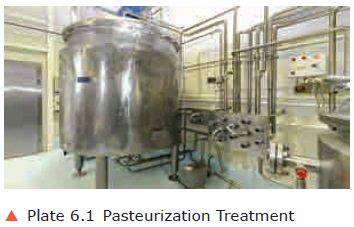
There are three methods of
pasteurization.
a. Bottle or Holding Pasteurization: This method
is commonly used for the preservation of fruit juices. The extracted juice is
strained and filled in bottles. The bottles are then sealed air tight and
pasteurized.
b. Over
Flow Method: Juice is heated to a temperature about 2.5oC higher than
the pasteurization temperature and filled in hot sterilized bottles.
The sealed bottles are sterilized at a temperature 2.5oC lower than
filling sealing temperature and then cooled.
c. Flash Pasteurization: The juice is heated
rapidly to a temperature of about 5.5oC higher than the pasteur-ization temperature and
kept at this temperature for about a minute. This method has been developed
specially for canning of natural orange juice, grape and apple juice. It has
the advan-tages of minimizing the flavor loss and preserving the vitamins.
2. Canning:
Canning is the process in which the foods are heated in hermetically sealed
(airtight) jars or cans to a temperature that destroys microorganisms and
inactivates enzymes that can cause food spoilage.
The general steps to be adopted for canning foods are cleaning,
blanching, filling, exhausting, sealing, sterilizing, cooling and labeling.
i. Cleaning:
It is the first step in canning. Thorough cleaning of the product to
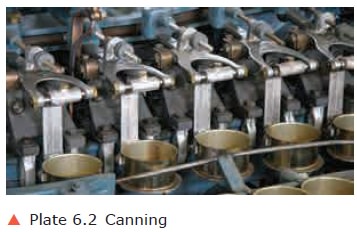
ii. Blanching:
This process serves as an additional hot water wash. It inactivates
the food enzymes and fixes the natural colour of the product. It also softens
the fibrous plant tissues and facilitates removal of skin. In this process the
raw food material is immersed in hot water or exposed to live steam for 2–5
minutes and immediately dipped into cold water to prevent further exposure to
heat.
iii. Filling:
Either manually or by using machinery the contents can be filled in the
cans. A headspace of 6–9mm depth above the level of food in the can must be
left.
iv. Exhausting:
Gases are expelled by passing the open can containing the food
through an exhaust box in which hot water or steam is used. It expands the food
and expels air and other gases from contents and also from the head space area
of the can.
v. Sealing:
The exhausted contain-ers are immediately sealed to avoid
re-contamination.
vi. Sterilization:
To bring about com-plete sterilization, thermal process is carried out.
This ensures the destruc-tion of spoilage microorganisms. This is usually done
by the application of steam under pressure.
vii. Cooling:
The containers are cooled rapidly to check the action of heat and
prevent unnecessary softening of the food or change in the colour of the
contents. It can be done by means of air or water.
viii. Labelling: The containers are labelled with nutritional characteristics of the
food inside.
C. Preservation by Drying
Microorganisms need moisture to grow. When exposed to sunlight or
subjected to dehydration, the moisture in the food is removed and the
concentration of water is brought below a certain level. This pre-vents the
growth of microorganisms and thereby spoilage of food. Food preserva-tion by
drying is one of the oldest meth-ods practiced from ancient times. This method
consists of exposing food to sun-light and air until the product is dry. It is
a very useful and economical process.
Both the terms ‘drying’ and ‘dehy-dration’ mean the removal of water. Drying
is used to remove moisture by the application of unconventional energy sources
like sun and wind. Dehydration means the process of removal of moisture by the
application of artificial heat under controlled conditions of temperature,
humidity and air flow.
Treatment of Foods Before Drying
a.
Selection
and sorting for size, maturity and wholesomeness
b.
Washing, especially fruits and vegetables
c.
Peeling
of fruits and vegetables by hand, machine or knife
d.
Subdivision
into halves, slices, shreds or cubes
e.
Blanching or scalding of vegetables and some fruits
like tomatoes and peaches
f.
Sulphuring of light coloured fruits and vegetables
by exposure to sul-phur-di-oxide gas.
i. Sun Drying: It is limited to regions with hot climates and dry atmosphere and to
certain fruits such as raisins, prunes, figs, apricots, pears and peaches. It
is a slow process. Many Indian foods are preserved by sun drying. Papads,
vadams and vathals
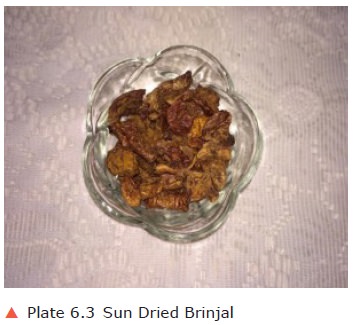
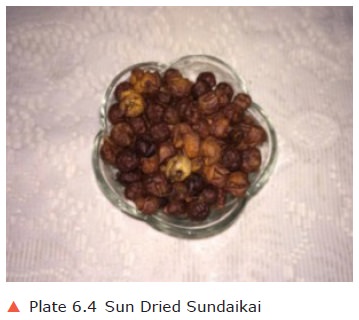

Vegetables like sundaikai, cluster beans,
bitter gourd and green chillies are preserved by this method. Fish and meat are
also sun dried. The common dried fish or karuvadu (local name) is a good
example for sun drying.
ii. Drying by Mechanical Driers: Artificial drying involves the passage of hot air with controlled relative humidity over the food to be dried or the passage of the food through such air. Fruits, vegetables, nuts, fish and meat can be successfully preserved by this method. In the dehy-dration process, artificial drying methods like spray drying, vacuum drying, drum drying and freeze drying are used for dry-ing foods.
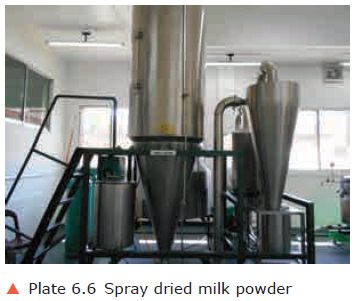
Although it is expensive when compared to natural sun-drying
process, it is very hygienic, rapid and the products obtained are uniform in
colour because the temperature and relative humidity can be maintained.
i. Spray drying: Milk and eggs are dried to a powder in spray driers in
which the liquid is atomized and sprayed into hot air steam or almost instant
drying.
ii. Foam mat drying: Foam mat drying may be used commercially to
preserve orange and tomato juice. In this pro-cess a small amount of edible
foam sta-bilizer is used. The foam is spread in a thin layer and dried in a
steam of hot air. The product gets separated easily into small particles on
cooling.
iii. Drying by osmosis: Drying by
osmo-sis results when fish is heavily salted. In this case, the moisture is
drawn out from all the cell tissues. The water is then bound with the solute
making it unavailable to the microorganisms. In osmotic dehydration of fruits,
the method involves the partial dehydra
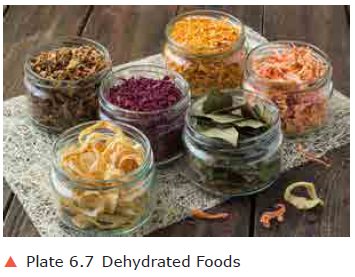
iv. Freeze drying: Removal of water from a frozen product by sublimation
is called freeze drying. Freeze dried foods will be of superior quality with
light and porous texture.

D. Preservation by Irradiation
Food irradiation also known as cold steri-lization is another
preservation technique. The foods are bombarded by high energy rays called
gamma rays or by fast mov-ing electrons to kill bacteria, fungi and insects and
in some cases to delay fruit ripening or prevent sprouting in onions and
potatoes. The goal of irradiation is to kill the microorganisms and inactivate
the enzymes without altering the food.
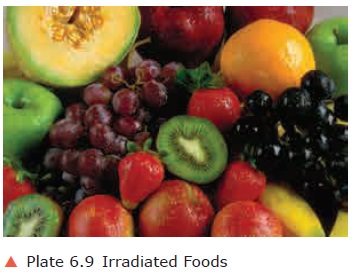
2. Chemical Methods
A. Salt or Brine
It is an ancient preservation technique. Food is treated with salt or
strong salt solution. Salt causes high osmotic pressure and shrinking of cell,
dehydrates foods and microbes by drawing out moisture.
B. High Concentration of Sugar
Sugar has the ability to bind water and make it unavailable for
microbial growth. It reduces the solubility of oxygen in mois-ture, which is
essential for the growth and multiplication of microorganisms. Apples, oranges,
guavas, grapes and pineapples are suitable for making jams and jellies. The
fruits should be just ripe because the pectin content is high in such fruits.
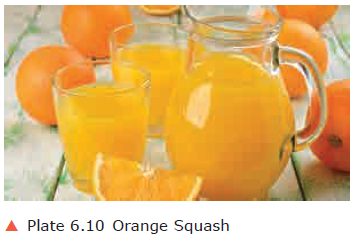
C. Using chemical preservatives
The chemicals when added interfere with the cell membrane of the
microorganisms, their enzyme activity or their genetic mechanisms. They also
act as antioxi-dants. The common chemical preserva-tives permitted are
1. Benzoic acid (including benzoates) Sodium benzoate is a salt of
benzoic acid and is used in preservation of coloured fruit juices and squashes.
2. Sulphur dioxide (including sulphites): Potassium meta-bi-sulphite is
used as a source of sulphur dioxide when it is added to the juice or squash.
When used in fruits with deep colours like blue grapes, jamun, watermelon it
bleaches the colour and hence in such cases benzoic acid is desirable.
3. Organic
acids and their salts:
Foods can be preserved by adding lactic, acetic, propionic, citric acids
and their salts. Nitrates and nitrite compounds are used to preserve meat and
fish prod-ucts. It gives desirable colour, flavor and discourages the growth of
micro-organ-isms. It also prevents toxin formation by the microorganisms in
food.
Related Topics